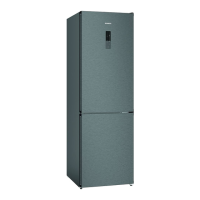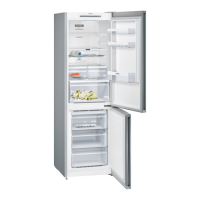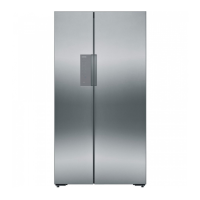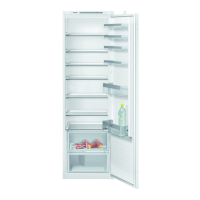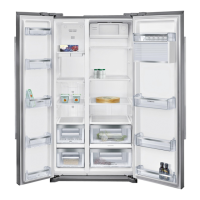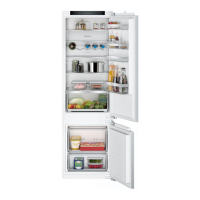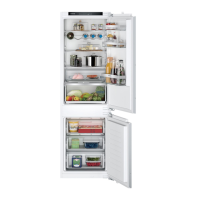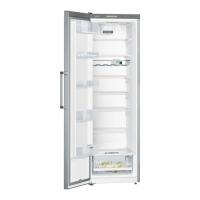
Do you have a question about the Siemens iQ300 KG55N Series and is the answer not in the manual?
| Type | Fridge-freezer |
|---|---|
| Frost Free | Yes |
| Climate class | SN-T |
| Number of Shelves | 4 |
| Installation type | Freestanding |
Read this instruction manual carefully and keep it for future reference or the next owner.
Only use this appliance for chilling/freezing food and making ice cubes in private households.
Appliance usage by children and people with reduced abilities requires supervision or instruction.
Warning about the high weight of the appliance which may result in injury when lifted.
Warnings about electric shock, explosion, and fire risks associated with incorrect installation.
Safety precautions regarding electric shock, suffocation, and explosion risks during appliance use.
Instructions and warnings for dealing with a damaged appliance or power cord.
Packaging materials are environmentally compatible and can be recycled. Sort components by type.
Instructions to reduce energy consumption by selecting installation location and usage habits.
Check all parts after unpacking for transport damage and completeness.
Warning about risks if the appliance is in a space that is too small, and permitted room temperatures.
Install the appliance in accordance with the enclosed installation instructions.
Steps to prepare the appliance before its first use.
Instructions on how to connect the appliance to the power supply.
Overview of the parts of the appliance.
Explanation of how to use the control panel to configure functions and view operating status.
Instructions on how to remove and re-insert shelves to vary their position.
Information on the storage container and recommended temperature settings for perishable food.
Guide to storing fruit and vegetables using the humidity controller for extended freshness.
How to adjust and remove the door rack as needed.
Information on using original accessories like egg trays and bottle shelves.
Steps to electrically connect the appliance and set the required temperature.
Advice on appliance operation, including initial cooling, door vacuum, and temperature variations.
Instructions on how to disconnect the appliance from the power supply.
Guide on setting temperatures for the refrigerator and storage container compartments.
Explanation of the Super cooling function for rapid cooling of the refrigerator compartment.
How automatic Super freezing works to cool the freezer compartment faster.
Guide to manual Super freezing for rapid freezing of large quantities of food.
How to set the appliance to save energy using the energy-saving mode.
Explanation of the door alarm that activates when the appliance door is open for too long.
Information about the temperature alarm that signals if the freezer compartment becomes too warm.
Advice on storing food correctly in the refrigerator to maintain freshness.
Explanation of different temperature zones within the refrigerator compartment.
Information on how to determine the appliance's freezing capacity.
Tips on how to maximize storage space in the freezer compartment.
Guidelines for proper storage of food within the freezer compartment.
Recommendations for freezing fresh food to ensure quality.
Table showing storage times for various foods at -18 °C.
Methods for defrosting different types of frozen food safely.
Information that the NoFrost system means defrosting is not required.
Steps to disconnect power, remove food and fittings before cleaning.
Instructions and warnings for cleaning the appliance, avoiding certain cleaning agents.
How to thoroughly clean fittings by removing them from the appliance.
Troubleshooting steps for when the appliance is not cooling, displays, and lighting are lit.
Steps to troubleshoot when the LED lighting does not function.
Information that warm side panels are normal due to the cooling process.
How to switch off the warning tone and alarm if it sounds.
Action to take if the appliance door is left open.
Instructions to remove obstructions from external ventilation openings.
Advice regarding large quantities of fresh food and freezing capacity.
Troubleshooting for when the set temperature is not reached, often due to door open for long time.
Steps to take if the automatic defrosting function stops working.
Steps to check when the temperature varies significantly from the set point.
How to address condensation on appliance surfaces and shelves.
Explanation that normal operating noises are not faults.
Steps to take if the appliance is not level.
Steps to disconnect, empty, clean and leave the appliance open when not in use.
Warnings about health and fire risks during disposal and environmentally friendly disposal methods.
How to find the product and production numbers for customer service.

